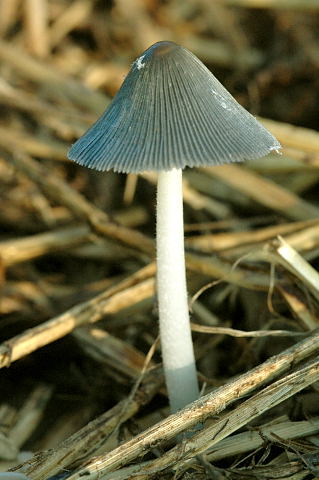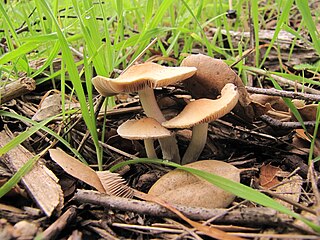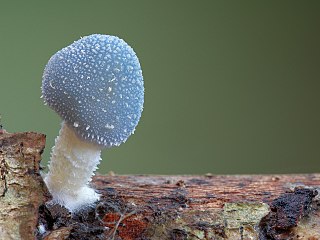
Taiga, generally referred to in North America as a boreal forest or snow forest, is a biome characterized by coniferous forests consisting mostly of pines, spruces, and larches.

Armillaria is a genus of fungi that includes the A. mellea species known as honey fungi that live on trees and woody shrubs. It includes about 10 species formerly categorized summarily as A. mellea. Armillarias are long-lived and form the largest living fungi in the world. The largest known organism covers more than 3.4 square miles (8.8 km2) in Oregon's Malheur National Forest and is estimated to be 2,500 years old. Some species of Armillaria display bioluminescence, resulting in foxfire.

The Psathyrellaceae are a family of dark-spored agarics that generally have rather soft, fragile fruiting bodies, and are characterized by black, dark brown, rarely reddish, or even pastel-colored spore prints. About 50% of species produce fruiting bodies that dissolve into ink-like ooze when the spores are mature via autodigestion. Prior to phylogenetic research based upon DNA comparisons, most of the species that autodigested were classified as Coprinaceae, which contained all of the inky-cap mushrooms. However, the type species of Coprinus, Coprinus comatus, and a few other species, were found to be more closely related to Agaricaceae. The former genus Coprinus was split between two families, and the name "Coprinaceae" became a synonym of Agaricaceae in its 21st-century phylogenetic redefinition. Note that in the 19th and early 20th centuries the family name Agaricaceae had far broader application, while in the late 20th century it had a narrower application. The family name Psathyrellaceae is based on the former Coprinaceae subfamily name Psathyrelloideae. The type genus Psathyrella consists of species that produce fruiting bodies which do not liquify via autodigestion. Psathyrella remained a polyphyletic genus until it was split into several genera including 3 new ones in 2015. Lacrymaria is another genus that does not autodigest its fruiting bodies. It is characterized by rough basidiospores and lamellar edges that exude beads of clear liquid when in prime condition, hence the Latin reference, lacryma (tears).

Coprinopsis is a genus of mushrooms in the family Psathyrellaceae. Coprinopsis was split out of the genus Coprinus based on molecular data. The species Coprinopsis cinerea is a model organism for mushroom-forming basidiomycota, and its genome has recently been sequenced completely.

Coprinopsis cinerea is a species of mushroom in the family Psathyrellaceae. Commonly known as the gray shag, it is edible, but must be used promptly after collecting.

Canada's boreal forest is a vast region comprising about one third of the circumpolar boreal forest that rings the Northern Hemisphere, mostly north of the 50th parallel. Other countries with boreal forest include Russia, which contains the majority; the United States in its northernmost state of Alaska; and the Scandinavian or Northern European countries. In Europe, the entire boreal forest is referred to as taiga, not just the northern fringe where it thins out near the tree line. The boreal region in Canada covers almost 60% of the country's land area. The Canadian boreal region spans the landscape from the most easterly part of the province of Newfoundland and Labrador to the border between the far northern Yukon and Alaska. The area is dominated by coniferous forests, particularly spruce, interspersed with vast wetlands, mostly bogs and fens. The boreal region of Canada includes eight ecozones. While the biodiversity of regions varies, each ecozone has a characteristic native flora and fauna.

Coprinopsis lagopus is a species of fungus in the family Psathyrellaceae. Until 2001, the species was known as Coprinus lagopus; advances in the understanding of phylogenetic relationships between the various coprinoid species led to a major reorganization of that genus. It is a delicate and short-lived fungus, the fruit bodies lasting only a few hours before dissolving into a black ink – a process called deliquescence. The vague resemblance of the young fruit body to the paw of a white rabbit has earned this species the common name harefoot mushroom.

Coprophilous fungi are a type of saprobic fungi that grow on animal dung. The hardy spores of coprophilous species are unwittingly consumed by herbivores from vegetation, and are excreted along with the plant matter. The fungi then flourish in the feces, before releasing their spores to the surrounding area.
Hebeloma vinosophyllum is a toxic species of agaric fungus in the family Hymenogastraceae. It contains eleven poisonous compounds collectively known as hebevinosides. An ammonia fungus, it tends to grow on the corpses of animals. The species was described by Japanese mycologist Tsuguo Hongo in 1965. It was recorded from Vietnamese Pinus kesiya forests in 2014, its first record in Southeast Asia.

Laccaria amethystina, commonly known as the "amethyst deceiver", is a small brightly colored mushroom, that grows in deciduous and coniferous forests. The mushroom itself is edible, but can absorb arsenic from the soil. Because its bright amethyst coloration fades with age and weathering, it becomes difficult to identify, hence the common name "deceiver". This common name is shared with its close relation Laccaria laccata that also fades and weathers. It is found mainly in Northern temperate zones, though it is reported to occur in tropical Central and South America as well. Recently, some of the other species in the genus have been given the common name of "deceiver".
Ammonia fungi are fungi that develop fruit bodies exclusively or relatively abundantly on soil that has had ammonia or other nitrogen-containing materials added. The nitrogen materials react as bases by themselves, or after decomposition. The addition of ammonia or urea causes numerous chemical and biological changes, for examples, the pH of soil litter is increased to 8–10; the high alkaline conditions interrupts the process of nutrient recycling. The mechanisms of colonization, establishment, and occurrence of fruiting bodies of ammonia fungi has been researched in the field and the laboratory.

Phlebopus is a genus of fungi in the family Boletinellaceae. The genus has a widespread distribution in subtropical and pantropical regions, and contains 12 species. The species are saprobic, with some possibly able to form mycorrhizae with exotic trees in certain conditions. It contains the gigantic Phlebopus marginatus, the cap of which can reach 1 m (3.3 ft) in diameter.

Coprinopsis variegata, commonly known as the scaly ink cap or the feltscale inky cap, is a species of fungus in the family Psathyrellaceae. Distributed in eastern North America, it has a medium-sized, bell-shaped to flattened cap up to 7.5 cm (3.0 in) in diameter, with felt-like, patchy scales. The gills, initially white, turn black in maturity and eventually dissolve into a black "ink". Fruit bodies grow in clusters or groups on leaf litter or rotted hardwood, although the wood may be buried, giving the appearance of growing in the soil. The fungus is found in the United States, in areas east of the Great Plains. Coprinus ebulbosus and Coprinus quadrifidus are names assigned by Charles Horton Peck to what he believed were species distinct from C. variegata; they were later shown to represent the same species, and are now synonyms. The mushroom is not recommended for consumption, and has been shown to cause allergic reactions in susceptible individuals.

Amanita frostiana, also known as Frost's amanita, is a small fungus species of eastern U.S. and southeastern Canada. The mushroom varies in colours from yellow, red or reddish pink usually.

Coprinopsis uliginicola is a species of agaric fungus in the family Psathyrellaceae. It was formally described by mycologists Kent McKnight and Alexander H. Smith in 1972. It was moved into the genus Coprinopsis in 2015 by Leif Örstadius & Ellen Larsson based on DNA sequences obtained from the holotype. Found in the United States, the paratype collection was made by Smith in the Nez Perce National Forest (Idaho) in 1962. Smith noted the species to also occur in New Mexico, Utah, and Wyoming, where it grows in wet areas under brush or on decaying aspen wood.

The boreal woodland caribou, also known as woodland caribou, boreal forest caribou and forest-dwelling caribou, is a North American subspecies of reindeer found primarily in Canada with small populations in the United States. Unlike the Porcupine caribou and barren-ground caribou, boreal woodland caribou are primarily sedentary.
Coprinopsis radiata is a coprophilous fungus that grows on herbivore dung. It is heterothallic.
Hebeloma radicosoides is a species of agaric fungus in the family Hymenogastraceae. Found in Japan, it was described as new to science in 2000. The mushroom's long rooting stipe and membranous ring give it an appearance similar to H. radicosum. Like that species, it is also an ammonia fungus, growing on soil containing urea.

Coprinopsis pulchricaerulea is a species of mushroom-producing fungus in the family Psathyrellaceae.














